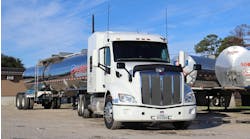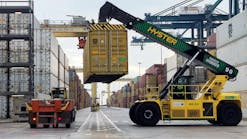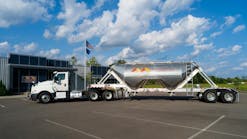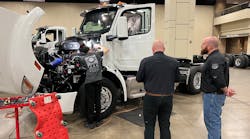Rush Enterprises and Rush Truck Centers recently hosted their annual Tech Skills Rodeo—a company-wide competition that showcases the best of the best across the company in a series of tests and events related to service, sales, and more.
The event has been going on for 17 years; spanning that period of time, the company has given away more than $2.7 million in cash and prizes. During the 2022 Rodeo, which took place December 11-13, winners received more than $300,000 in cash and prizes.
From the inaugural Rodeo having put less than 100 technicians to the test to having an event host more than 1,000 people, Rush has placed significant importance on highlighting its personnel in order to recognize those that do the work, but more importantly, reward and retain the best talent.
Victor Cummings, VP of Service Operations, and Jim Stickel, Director of Service, Navistar Division, at Rush Enterprises spoke to the significance of the event—and how engagement with employees can help retain the talent in-house.
“I’ll tell you that this event makes me extremely proud of the company that I work for,” Cummings said of the Rush Tech Skills Rodeo. “The first rodeo I attended was still just service technicians alone. And I don’t mean to minimize that; I’m saying it was only service technicians, and over the last several years that has now included the parts counter sales reps, aftermarket sales, truck sales, leasing... It’s an amazing event. 1,150 people were in attendance; it’s remarkable. I know nothing that comes close to it. And I think it speaks volumes of who we are as an organization, and the leadership of this organization.”
And how can a company put forth such recognition to its employees, especially considering there are around 8,000 company-wide? It takes a lot of effort to get an event together of this scale, though its significance is deliberate. The company believes that recognizing and rewarding talent can help to ease recruitment and retention problems. And it starts with engagement.
“Well, we’re leading in the industry. And then you see all these men and women competing, they’re the best of the best,” Stickel stated. “They use that. They’ll go back to the dealerships and talk about the experience that they had here. And it’s all about the engagement. It’s about leadership, and we have that from the top down. That’s the most important key: it’s all about that engagement.”
Both Cummings and Stickel started their careers on the shop floor, so they understand the challenges from multiple perspectives.
“From where I sit today, this is probably the most challenging environment I’ve experienced in my career in terms of hiring technicians,” Cummings said. “More specifically: retaining technicians. I don’t think Rush, nor the industry, really has a recruiting problem as much as we have a retention problem.
“The business has changed so radically from where it was when I started,” he continued. “There were more technicians than there were jobs, and so, you had to fight hard to get that opportunity and to retain that opportunity. The tides have turned; there are more positions than there are technicians. And that changes the dynamic on a number of levels.”
Engagement can mean many things; and though not every maintenance operation has the capacity to put on an event to the scale of the Rush Rodeo, there are other successful avenues available to pursue.
Stickel boasted a turnover rate in the low 20s (which Cummings said “is phenomenal in this industry”) at the company’s Columbus, Ohio, dealership—a rather large location. The success came from executing on multiple initiatives, such as establishing partnerships with trade schools, meeting with instructors and students prior to graduation, as well as selling PM service.
“It starts at the ground up,” Stickel said. “Our Level Ones are working on the PMs. We have to grow them into the industry, slowly; we can’t rush them in; we can’t throw them to the wolves. We have to collaborate and work with them… letting them know that we’re standing behind them and that we have their back, that we’re not going to turn away from them. We’re helping them along the way. We want to see them successful.”
Guiding early-career techs on the tasks at hand is certainly important, but just as important is guiding them along a career path in which they can see a developed future ahead of them versus a stagnant lack of progression.
“I was a technician, and I ask my young technicians today, ‘Where do you want to be 10 years from now? Do you want to be the next Victor Cummings or the next Jim Stickel?’ That path is clear. We at Rush make that very clear. And we want to see people succeed, we don’t want to see people stay at the same level throughout their career. So, we do everything in our power from training, working with them hand in hand, mentoring them, putting them with older techs that have more experience… we work with our younger technicians and that helps tremendously.”
But this isn’t a one-man initiative. It takes a village, so to say, and having everyone pitch in can make a difference in retaining talented technicians.
“It takes everybody to participate, collaborate, and embrace that technician, support that technician, to help them get started and be successful in our business,” Cummings said.
“The key is recognizing your employee; engagement with the employee; providing that career path, letting them know and demonstrating to them that they are valued in that organization and just how important their contribution is,” Cummings emphasized. “And that’s really what this Rodeo is all about. It’s obviously for Rush and it’s on a much grander scale, but anybody can do that.”
This article originally appeared on FleetMaintenance.com.









